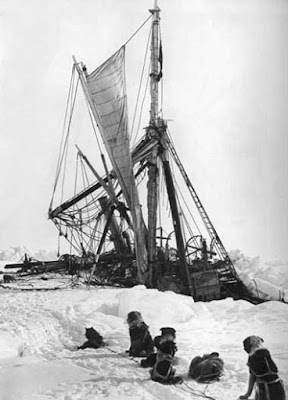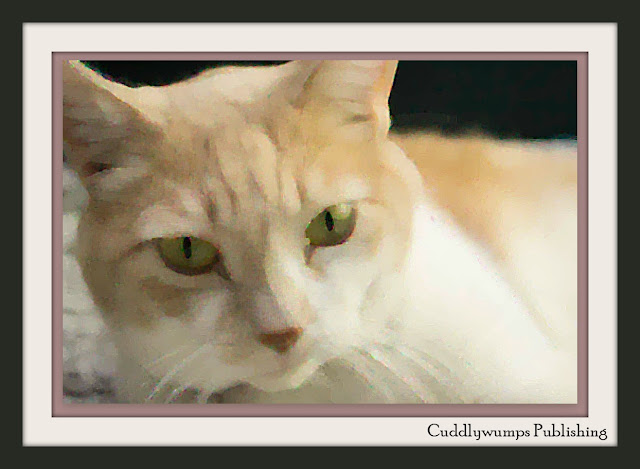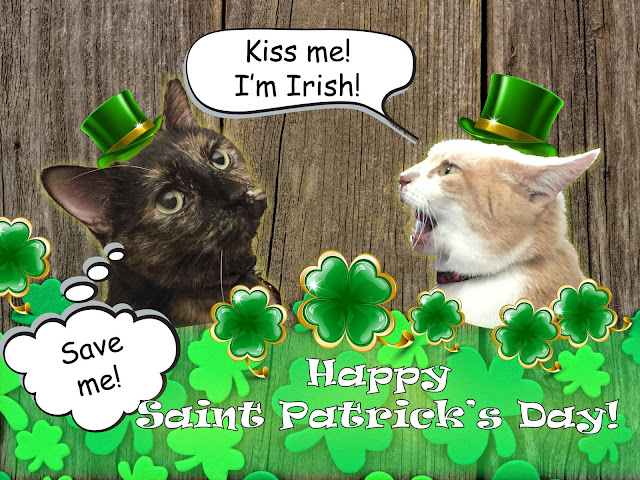 |
The male tabby named Mrs. Chippy perches on Perce Blackborow's
shoulder aboard the Endurance, 1914.
By Frank Hurley [Public domain], via Wikimedia Commons |
Years ago, people went off in sailing ships to explore far-flung
parts of the globe, and they took cats with them. For one thing, cats were good
company, capable of providing light entertainment, and for another thing, cats were
rather good at killing the mice and rats that inevitably hitched a ride on the
ships. One of the most famous of these cats was Mrs. Chippy, a tabby cat from
Glasgow, Scotland, who wasn’t a “Mrs.” at all and who sailed to Antarctica with
Ernest Shackleton, never to return.
Mrs. Chippy joins the expedition
In 1914, Ernest Shackleton was putting together something
called the Imperial Trans-Antarctic Expedition (also known as the
Endurance Expedition). Shackleton
intended to make the first land crossing of the Antarctic continent. For this, he
needed crews for two ships, and a Scotsman named Harry McNish (also spelled “McNeish”)
joined up as the carpenter for the
Endurance.
As the story goes, McNish found his tabby cat curled up in his toolbox, and
he took this as sign that the cat wanted to come with him. So, when McNish boarded
the ship in London, along came the tabby.
“Chippy” is a British nickname for a carpenter, and the
tabby quickly came to be called Mrs. Chippy for her habit of sticking close to
McNish. The cat had been on board for a month before the crew discovered that Mrs. Chippy was
actually Mr. Chippy, but still the
original name stuck.
Heading south, Mrs. Chippy makes a new friend
 |
The Endurance in full sail, c. 1915.
By Frank Hurley [Public domain],
via Wikimedia Commons. |
The Endurance sailed
on August 8, 1914, for Buenos Aires. It was during the stop there that young
Perce Blackborow, still just a teen, stowed away on the ship. Blackborow was
allowed to stay after he was discovered, and he became a friend of Mrs. Chippy.
The only known photo of the cat shows him perched on Blackborow’s shoulder.
Mrs. Chippy was well liked by the crew. He was friendly, a
good mouser, and known for his ability to balance on the ship’s rails even in
rough seas. He was less popular among the sled dogs, as he liked to tease them
by walking atop the kennels they were kept in.
 |
Map showing the planned route
of the expedition.
March 25, 1916.
Public Domain, via Wikimedia Commons. |
From Buenos Aires, the expedition sailed on to South Georgia
and then to Antarctica. The plan for the Endurance
was to land a party in a bay off the Weddell Sea. From there, the explorers
would trek across the continent to the Ross Sea, by way of the South Pole. Meanwhile,
a second ship, the Aurora, was to
sail on to the Ross Sea. But things did not go to plan.
Trapped
The Endurance
encountered ice along the way to the intended landing site, which presented
more difficulties than Shackleton had anticipated, and the ship eventually became
trapped in pack ice in 1915. At first,
Shackleton had the men try to free the ship with chisels and saws, but it was
no use, and they all realized they’d be spending the winter on the ice. They
tried to get word out with their wireless, but they were too far away from
civilization for it to work. The sled dogs were taken off the ship and housed
in “dogloos” (kennels made of ice). Mrs. Chippy mostly preferred to stay aboard the
ship.
 |
The Eundurance, crushed and sinking,
November 1915. A few of the sled dogs
are seen in the foreground.
By Royal Grographic Society [Public domain],
via Wikimedia Commons |
Things went tolerably well until October, when the ice truly
began to crush the ship. Endurance
had to be abandoned on October 27, 1915. The men and animals who’d been aboard her
were well and truly stuck. A new plan was needed, but unfortunately for Mrs.
Chippy, it did not include a cat.
The end for Mrs. Chippy
Shackleton determined that their best chance of surviving lay
in marching across the ice to the west to reach the nearest land, some 350
miles away. He determined that only the strong would survive this journey, and
he ordered the crew to shoot the weakest animals, including Mrs. Chippy. This
was carried out on October 29. Shackleton wrote, “This afternoon Sallie’s three youngest pups, Sue’s Sirius,
and Mrs. Chippy, the carpenter’s cat, have to be shot. We could not undertake
the maintenance of weaklings under the new conditions.” Those who were closest
to the animals killed, including McNish, “seemed to feel the loss of their
friends rather badly.”
A long journey
toward rescue
 |
Harry McNish, 1914.
Portrait cropped from photo in
South with Endurance.
Public domain,
via Wikimedia Commons. |
The
march was short-lived, as it proved too difficult to negotiate the uneven ice. The
crew instead made camp not far from the ship and waited for the ice to break
up. They were able to retrieve more supplies from the Endurance until the ship finally sank on November 21. By April
1916, they had drifted to within sight of land, and with their ice pack
breaking up, Shackleton decided it was time to try a lifeboat journey. In three
lifeboats, the crew made a perilous, icy trip to Elephant Island.
It was good
that they had reached land, but the land they reached was uninhabited.
Shackleton needed to make one more dangerous lifeboat journey to get help. He
and five others, including McNish, set off for South Georgia. Although the boat
quickly became covered in ice, they reached the island on May 10, over two
weeks after setting out. But still the ordeal wasn’t over, as South Georgia’s
whaling stations were on the northern coast, and the sailors and landed to the
south. Next came a land crossing of South Georgia’s interior. McNish and two
others were not well enough to make this part of the journey, and they were
left in a makeshift camp. They would be rescued by a whaler after Shackleton
reached a station on the island. Shackleton also returned to Elephant Island to
rescue the men left there. In the meantime, Blackborow’s left foot had had to be amputated after it
became frostbitten and gangrenous.
The carpenter and
his cat reunited
 |
The statue of Mrs. Chippy added to
Harry Mcnish's grave in
Karori Cemetery, Wellington, by the
New Zealand Antarctic Society in 2004.
By Nigel Cross, via Wikimedia Commons. |
McNish
never forgave Shackleton for ordering that Mrs. Chippy be shot. He and
Shackleton had had their differences from the start of the expedition, and Shackleton wrote that the Scottish carpenter was "the only man I'm not dead certain of." After the Endurance became stuck on the ice, the two men butted heads over exactly what should be done to effect the crew’s rescue,
and at one point McNish even refused to follow Shackleton’s orders. Despite this,
the carpenter worked hard to build shelters for the crew and to save the Endurance, and of course he was part of the crew on that harrowing lifeboat journey to South Georgia. However, Shackleton denied him the
Polar Medal that most of the crewmen received after their ordeal. Harry McNish died destitute in New Zealand
in 1930. He was 64.
In 2004, McNish and Mrs. Chippy were reunited, in a way, when the New Zealand
Antarctic Society added a bronze statue of the cat to the carpenter’s grave. A
fitting close to the story of a cat who set out on an ill-fated adventure just because
he curled up in a toolbox.
Sources
Wikipedia: “
Harry McNish,” “
Imperial Trans-Antarctic Expedition,” “
Mrs. Chippy.”













































